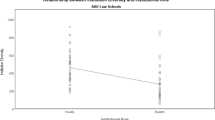Abstract
Fragmentation in the academic profession derived from differences among academics in different types of colleges and universities suggests a need to identify possible compensatory integrating mechanisms. This study seeks to determine whether faculty conformity to the four norms of science identified by Merton are such integrating mechanisms or whether they are forces of further fragmentation. The 1977 Survey of the American Professorate conducted by Ladd and Lipset was the data source for this study. The results indicate that the norms of universalism and communality serve as a compensatory integrating mechanisms, while the norms of disinterestedness and organized skepticism function as forces of further fragmentation among academics in different types of colleges and universities.
Similar content being viewed by others
References
Becker, T. (1987). The disciplinary shaping of the profession. In Burton R. Clark (ed.),The Academic Profession (pp. 271–303). Los Angeles: University of California Press.
Biglan, A. (1973). Relationships between subject matter characteristics and the structure and output of university departments.Journal of Applied Psychology 57: 204–213.
Blau, P. (1973).The Organizations of Academic Work. New York: Wiley.
Bowen, H., and Schuster, J. (1986).American Professors: A National Resource Imperiled. New York: Oxford University Press.
Braxton, J. M. (1986). The normative structure of science: Social control in the academic profession. In J. C. Smart (ed.),Higher Education: Handbook of Theory and Research, Volume II (pp. 309–357). New York: Agathon.
Bucher, R., and Strauss, A. (1961). Professions in process,American Journal of Sociology 66: 325–334.
Carmines, E. G., and Zeller, R. A. (1979).Reliability and Validity Assessment. Beverly Hills: Sage.
Carnegie Commission on Higher Education (1973).A Classification of Institutions of Higher Education. Berkeley, CA: Carnegie Commission.
Clark, B. R. (1983).The Higher Education System. Berkeley: University of California Press.
Finkelstein, M. J. (1984).The American Academic Profession. Columbus: Ohio State University Press.
Fulton, O., and Trow, M. (1974). Research activity in American higher education.Sociology of Education 47 (Winter): 29–73.
Gibbs, J. P. (1981).Norms, Deviance, and Social Control: Conceptual Matters. New York: Elsevier.
Goode, W. J. (1957). Communality within a community: The professions.American Sociological Review 22: 194–200.
Ladd, E. C., Jr. (1979). The work of American college professors: Some data and an argument, AAHE.Current Issues in Higher Education.
Ladd, E. C., Jr., and Lipset, S. M. (1978).Technical Report, 1977 Survey of the American Professoriate. Storrs: Social Science Data Center, University of Connecticut.
Light, D. (1974). The structure of the academic professions.Sociology of Education 47: 2–28.
Lodahl, J. B., and Gordon, G. (1972). The structure of scientific fields and the functioning of university graduate departments.American Sociological Review 37: 57–72.
Martindale, D. (1980). King of the hoboes: Portrait of an international cultural workman. In D. Martindale and R. Mohan (eds.),Ideals and Realities: Some Problem Areas of Professional Social Science. Ghaziabad, India: International Press.
Merton, R. K. (1942). Science, technology in a democratic order.Journal of Legal and Political Sociology 1: 115–126.
Merton, R. K. (1973).The Sociology of Science. Chicago: University of Chicago Press.
Mitroff, I. I. (1974). Norms and counter-norms in a select group of the Apollo moon scientists: A case study of the ambivalence of scientists.American Sociological Review 39: 579–595.
Mulkay, M. (1976). Norms and ideology in science.Social Science Information 15: 637–656.
Myers, J. L. (1972).Fundamentals of Experimental Design. Boston: Allyn and Bacon.
Parsons, T., and Platt, G. (1968). The American academic profession: A pilot study. National Science Foundation (mimeographed.).
Parsons, T., and Platt, G. (1973).The American University. Cambridge, MA: Harvard University Press.
Reiss, A. (1975). Surveys of self-reported delicts. Unpublished paper prepared for the Symposium on Studies of Public Experience, Knowledge, and Opinion of Crime and Justice, Washington, D.C.
Rothman, R. A. (1972). A dissenting view on scientific ethos.British Journal of Sociology 23: 102–108.
Ruscio, K. P. (1987). Many sectors, any professions. In Burton R. Clark (ed.),The Academic Profession (pp. 331–368). Los Angeles: University of California Press.
Shils, E. (1983).The Academic Ethic. Chicago: University of Chicago Press.
Stehr, N. (1987). The ethos of science revisited: Social and cognitive norm. In J. Gaston (ed.),The sociology of Science (pp. 172–196), San Francisco: Jossey-Bass.
Toombs, W. (1975). A three dimensional view of faculty development.Journal of Higher Education 46 (6): 701–717.
Zuckerman, H. (1977). Deviant behavior and social control in science. In E. Sagaren (ed.),Deviance and Social Change (pp. 87–138). Beverly Hills: Sage.
Author information
Authors and Affiliations
Rights and permissions
About this article
Cite this article
Braxton, J.M. Institutional variability in faculty conformity to the norms of science: A force of integration or fragmentation in the academic profession?. Res High Educ 30, 419–433 (1989). https://doi.org/10.1007/BF00992564
Received:
Issue Date:
DOI: https://doi.org/10.1007/BF00992564




